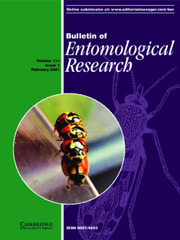Ver ítem
- xmlui.general.dspace_homeCentros e Institutos de InvestigaciónCICVyA. Centro de Investigación en Ciencias Veterinarias y AgronómicasInstituto de GenéticaArtículos científicosxmlui.ArtifactBrowser.ItemViewer.trail
- Inicio
- Centros e Institutos de Investigación
- CICVyA. Centro de Investigación en Ciencias Veterinarias y Agronómicas
- Instituto de Genética
- Artículos científicos
- Ver ítem
Precocious sexual signalling and mating in Anastrepha fraterculus (Diptera: Tephritidae) sterile males achieved through juvenile hormone treatment and protein supplements
Resumen
Sexual maturation of Anastrepha fraterculus is a long process. Methoprene (a mimic of juvenile hormone) considerably reduces the time for sexual maturation in males. However, in other Anastrepha species, this effect depends on protein intake at the adult stage. Here, we evaluated the mating competitiveness of sterile laboratory males and females that were treated with methoprene (either the pupal or adult stage) and were kept under different regimes of
[ver mas...]
Sexual maturation of Anastrepha fraterculus is a long process. Methoprene (a mimic of juvenile hormone) considerably reduces the time for sexual maturation in males. However, in other Anastrepha species, this effect depends on protein intake at the adult stage. Here, we evaluated the mating competitiveness of sterile laboratory males and females that were treated with methoprene (either the pupal or adult stage) and were kept under different regimes of adult food, which varied in the protein source and the sugar:protein ratio. Experiments were carried out under semi-natural conditions, where laboratory flies competed over copulations with sexually mature wild flies. Sterile, methoprene-treated males that reached sexual maturity earlier (six days old), displayed the same lekking behaviour, attractiveness to females and mating competitiveness as mature wild males. This effect depended on protein intake. Diets containing sugar and hydrolyzed yeast allowed sterile males to compete with wild males (even at a low concentration of protein), while brewer´s yeast failed to do so even at a higher concentration. Sugar only fed males were unable to achieve significant numbers of copulations. Methoprene did not increase the readiness to mate of six-day-old sterile females. Long pre-copulatory periods create an additional cost to the management of fruit fly pests through the sterile insect technique (SIT). Our findings suggest that methoprene treatment will increase SIT effectiveness against A. fraterculus when coupled with a diet fortified with protein. Additionally, methoprene acts as a physiological sexing method, allowing the release of mature males and immature females and hence increasing SIT efficiency.
[Cerrar]

Autor
Liendo, María Clara;
Devescovi, Francisco;
Bachmann, Guillermo Enrique;
Utges, María E.;
Abraham, Solana;
Vera, María Teresa;
Lanzavecchia, Silvia Beatriz;
Bouvet, Juan Pedro;
Gomez Cendra, Paula V.;
Hendrichs, Jorge;
Teal, Peter E. A.;
Cladera, Jorge Luis;
Segura, Diego Fernando;
Fuente
Bulletin of Entomological Research 103 (1) : 1-13 (Febrero 2013)
Fecha
2013-02
Editorial
Cambridge University Press
ISSN
0007-4853
URI
http://hdl.handle.net/20.500.12123/8742
https://www.cambridge.org/core/journals/bulletin-of-entomological-research/article/abs/precocious-sexual-signalling-and-mating-in-anastrepha-fraterculus-diptera-tephritidae-sterile-males-achieved-through-juvenile-hormone-treatment-and-protein-supplements/D5EA8173FC40939D1E2B93A7E30915A2
https://www.cambridge.org/core/journals/bulletin-of-entomological-research/article/abs/precocious-sexual-signalling-and-mating-in-anastrepha-fraterculus-diptera-tephritidae-sterile-males-achieved-through-juvenile-hormone-treatment-and-protein-supplements/D5EA8173FC40939D1E2B93A7E30915A2
Formato
pdf
Tipo de documento
artículo
Palabras Claves
Derechos de acceso
Restringido
 Excepto donde se diga explicitamente, este item se publica bajo la siguiente descripción: Creative Commons Attribution-NonCommercial-ShareAlike 2.5 Unported (CC BY-NC-SA 2.5)
Excepto donde se diga explicitamente, este item se publica bajo la siguiente descripción: Creative Commons Attribution-NonCommercial-ShareAlike 2.5 Unported (CC BY-NC-SA 2.5)
Metadatos
Mostrar el registro completo del ítemÍtems relacionados
Mostrando ítems relacionados por Título, autor o materia.
-
The Use of hCG for Inducing Ovulation in Sheep Estrus Synchronization Impairs Ovulatory Follicle Growth and Fertility
Bruno Galarraga, María Macarena; Cano Moreno, Virginia; Lago Cruz, Beatriz; Encinas, Teresa; Gonzalez Bulnes, Antonio; Martinez Ros, Paula (MDPI, 2021-04)Currently, there is an intense effort to find an alternative hormone to eCG to induce ovulation after estrus synchronization treatments in sheep. One of the proposed alternatives is based on the use of hCG, but the results ... -
Plant chemicals and the sexual behavior of male tephritid fruit flies
Segura, Diego Fernando; Belliard, Silvina Ahnahi; Vera, María Teresa; Bachmann, Guillermo Enrique; Ruiz, María Josefina; Jofre-Barud, Flavia; Fernandez, Patricia Carina; Lopez, M. Liza; Shelly, Todd E. (Oxford University Press, 2018-09)Plant compounds affect insects in many different ways. In addition to being a food source, plants also contain secondary metabolites that may have positive and negative impacts on insects. The influence of these compounds ... -
Estudio de la perturbación del desarrollo sexual de Cnesterodon decemmaculatus (Pisces, Poeciliidae) por compuestos con actividad estrogénica
Young, Brian Jonathan (Departamento de Ciencias Biológicas, Facultad de Ciencias Exactas, Universidad Nacional de La Plata, 2019)En las últimas décadas, los compuestos con capacidad para afectar el sistema endocrino y la reproducción de los organismos han despertado gran preocupación en el mundo entero. Tales sustancias se conocen como perturbadores ...

